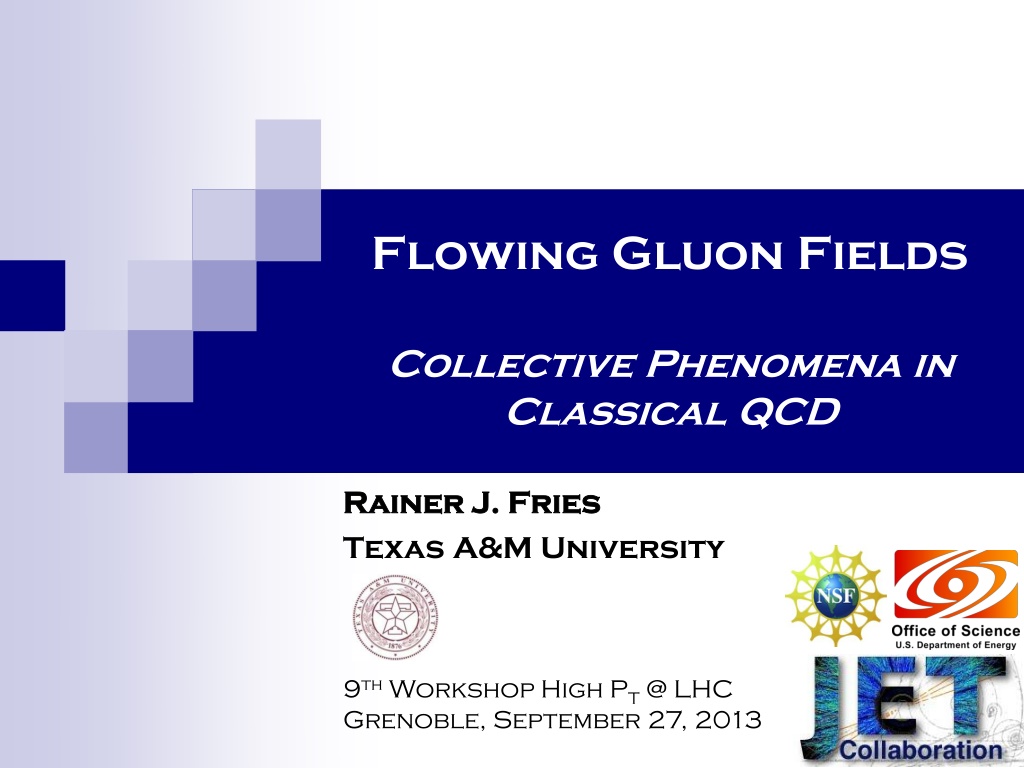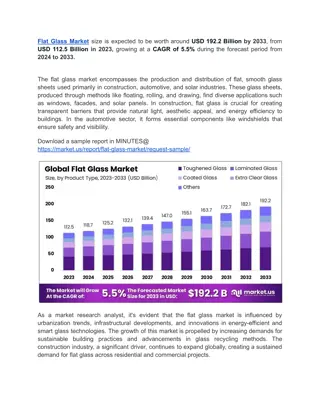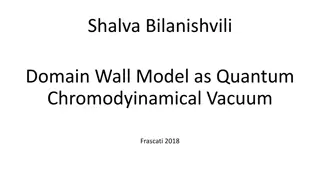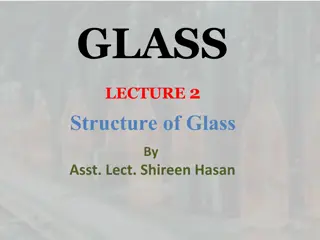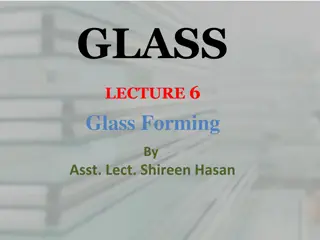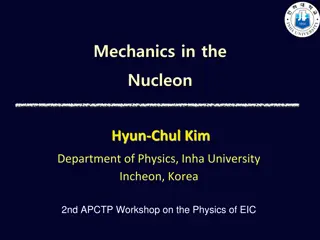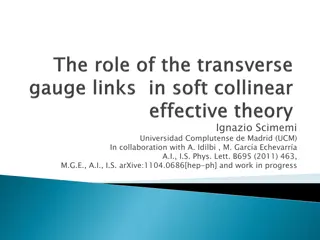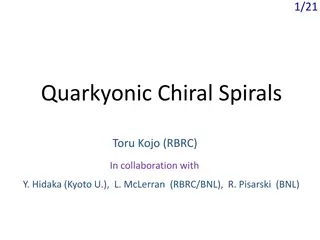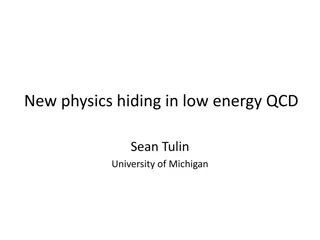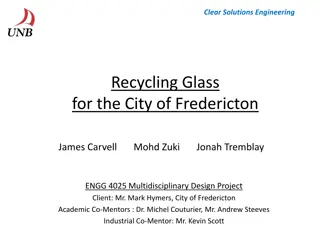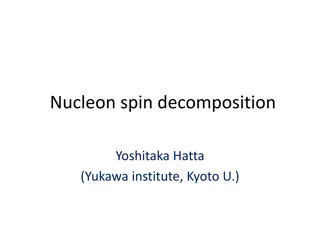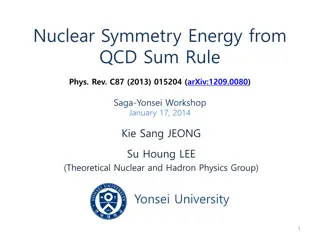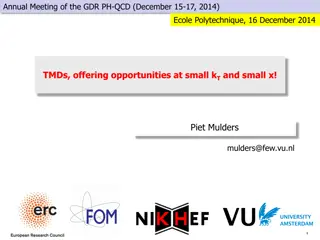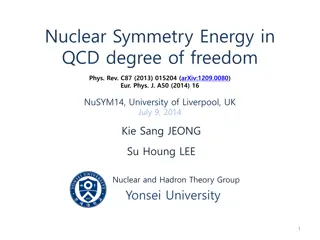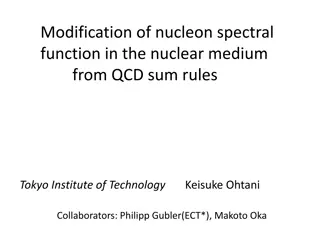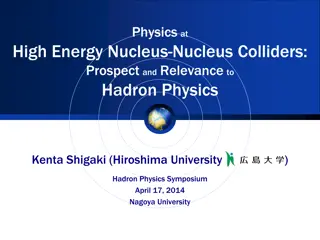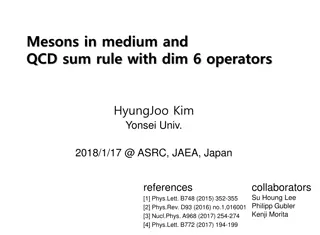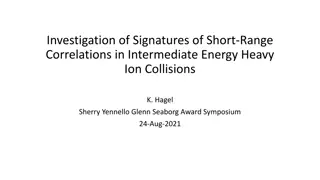Understanding Flowing Gluon Fields and Color Glass Phenomena in QCD
Explore the collective phenomena of gluon fields in classical QCD, focusing on the Standard Model of URHICs, Color Glass, and Gluon Fields in the Forward Lightcone. The research delves into topics like local thermal equilibrium, viscous hydrodynamics, and the interaction of probes with quarks and gluons. Understanding the dynamics of color glass in colliding nuclei sheds light on the energy-momentum tensor of early time gluon fields. Constraints are derived for the hydrodynamic evolution of the equilibrating QGP, emphasizing small-time expansions and numerical solutions.
Download Presentation

Please find below an Image/Link to download the presentation.
The content on the website is provided AS IS for your information and personal use only. It may not be sold, licensed, or shared on other websites without obtaining consent from the author. Download presentation by click this link. If you encounter any issues during the download, it is possible that the publisher has removed the file from their server.
E N D
Presentation Transcript
Flowing Gluon Fields Collective Phenomena in Classical QCD Rainer J. Fries Rainer J. Fries Texas A&M University 9th Workshop High PT @ LHC Grenoble, September 27, 2013
The Standard Model of URHICs Bulk of produced particles (< 2 GeV/c) Local thermal equilibrium during QGP phase Expansion and cooling via viscous hydrodynamics Maybe transport in the hadronic phase? Bulk time evolution: Hydro initial conditions: Some constraints from data on ellipticity and fluctuations in the transverse energy density: IP-Glasma = leading candidate Poor constraints on initial flow and other variables. What does color glass say about the global event shape? [B. Schenke, P. Tribedy, R. Venugopalan, PRL108 (2012)] Rainer Fries High PT @ LHC 2013 2
Color Glass: Single Nuclei Nuclei/hadrons at asymptotically high energy: Saturated gluon density ~ Qs-2 scale Qs >> QCD Probes interact with many quarks + gluons coherently. Large occupation numbers quasi-classical fields. Large nuclei are better: Qs ~ A1/3 Effective Theory a la McLerran & Venugopalan Solve Yang-Mills equations for gluon field A ( ). Sources = light cone currents J (given by SU(3) charge distributions = large-x partons). J F D = , Calculate observables O( ) from the gluon field A ( ). Compute O event by event or the expectation value of O by sampling or averaging over , resp. = random frozen color fluctuations of a color-neutral object. MV: weight W = Gaussian ( ) ( ) O d = O W [L. McLerran, R. Venugopalan] Rainer Fries High PT @ LHC 2013 3
Color Glass: Colliding Nuclei Yang-Mills equations: two sources 1, 2 Intersecting light cone currents J1, J2 (given by 1, 2) solve Yang- Mills equations for gluon field A ( 1, 2). Forward light cone (3): free Yang-Mills equations for fields A, Ai iA1 iA2 1 = 3 i i , , 0 A D D A 3 ( x ) = , A x A x 1 = i i , , 0 D A ig A A ( ) = i i , A A 0 = 1 2 i i j ji , , , A ig A D A D F [A. Kovner, L. McLerran, H. Weigert] ( ) ( ) ( ) = = + i i i 2 , 0 A x A x A x Boundary conditions on the forward light cone: 1 ig 2 ( ) ( ) ( ) i 1 = = i 2 , 0 , A x A x A x MV setup is boost-invariant, but not symmetric between + and direction. Rainer Fries High PT @ LHC 2013 4
Gluon Fields in The Forward Lightcone Goals: Calculate fields and energy momentum tensor of early time gluon field as a function of space-time coordinates. Analyze energy density and flow field. Derive constraints for further hydrodynamic evolution of equilibrating QGP. Small-time expansion Numerical solution [T. Lappi] ( ) ( )( A n ) n = n , A x x = n 0 ( ) ( )( n ) = i n i , A x A x = 0 Results: recursive solution for gluon field: + = + + 2 2 n m l k n n 1 = ( )( 0 ) ( ) ( ) i i , , A D D A = + i i i 2 A x A x A x ( ) ( ) n ( ) k ( ) l ( ) m 1 ig 2 n 1 n ( )( A 0 ) ( ) ( ) i 1 = + l + m = i 2 , x A x A x = + i j ji i , , , A D F ig A D A ( ) n ( ) k ( ) l ( ) 4 ( ) l ( ) m k 2 + = 2 k n k l [RJF, J. Kapusta, Y. Li, 2006] [Fujii, Fukushima, Hidaka, 2009] Rainer Fries High PT @ LHC 2013 5
Result: Fields Before the collision: color glass = pulse of strictly transverse (color) electric and magnetic fields, mutually orthogonal, with random color orientations, in each nucleus. ( ) x += i i F A 1 1 ( ) x = + i i 2 F A 2 Rainer Fries High PT @ LHC 2013 6
Result: Fields Before the collision: color glass = pulse of strictly transverse (color) electric and magnetic fields, mutually orthogonal, with random color orientations, in each nucleus. Immediately after overlap (forward light cone, 0): strong longitudinal electric & magnetic fields. Non-abelian effect! B 0 E 0 + = i i 2 , F ig A A E0 ( ) 0 1 = 21 ij i j , B0 F ig A A ( ) 0 1 2 [L. McLerran, T. Lappi, 2006] [RJF, J.I. Kapusta, Y. Li, 2006] Rainer Fries High PT @ LHC 2013 7
Result: Fields Before the collision: color glass = pulse of strictly transverse (color) electric and magnetic fields, mutually orthogonal, with random color orientations, in each nucleus. Immediately after overlap (forward light cone, 0): strong longitudinal electric & magnetic fields. Non-abelian effect! TransverseE, B fields start linearly in time ( ) Ei~ O ( ) Bi~ O ( ) e = i ij j i , , F D B D E ( ) 0 ( ) 0 ) 1 ( 0 0 2 2 [RJF, J.I. Kapusta, Y. Li, 2006] [G. Chen, RJF, PLB 723 (2013)] Rainer Fries High PT @ LHC 2013 8
Energy Momentum Tensor Initial ( = 0) structure of the energy-momentum tensor vs hydrodynamics. Particle distributions f: Gauge fields: 3 d p 0 ( ) p 1 p = T p p f f = + 2 Tr Tr T F F g F F p 2 e 0 1 fm/c p 0 T equ = = T ( f ) 0 p 0 p 0 Transverse pressure PT = 0 Later: Ideal plasma (local rest frame) Longitudinal pressure PL = 0 0=1 2+ ?0 2 2?0 p T Toward equilibrium: pressure isotropization (in local rest frame) L Rainer Fries High PT @ LHC 2013 9
Energy Momentum Tensor General structure up to order 2: ( 2 [RJF, J.I. Kapusta, Y. Li, (2006)] [G. Chen, RJF, PLB 723 (2013)] ) 1 E + 2 2 B = S E B ( ) 1 ( ) + O + + O O + 2 1 1 2 2 2 cosh sinh cosh sinh O O 0 ( ) 2 ( ) O + + O 1 2 2 1 1 cosh sinh sinh cosh = 0 T ( ) + ( ) 2 f O + + + 2 2 2 2 2 cosh sinh sinh cosh 0 ( ) ( ) + + 2 1 1 2 2 sinh cosh sinh cosh 0 Transverse Poynting vector gives transverse flow. Like hydrodynamic flow, determined by gradient of transverse pressure PT = 0; even in rapidity. = i i 0 2 ( ) = i ij j j , , D B E D E B Non-hydro like; odd in rapidity ?? 0 0 0 0 2 Depletion/increase of energy density due to transverse flow Example for second order: 8 2 ( ) = + 2 + 2 00 i i i i 2 sinh 2 cosh T 0 Due to longitudinal flow High PT @ LHC 2013 Rainer Fries 10
Modelling Color Charges So far everything written in terms of color charge densities 1, 2 MV: Gaussian distribution around color-neutral average ( ) ( x N c 1 ) ( ( ) x 2 g 2 ( ) x ( ) x ) = = 2 a i b j ab x x 1 1 2 x x dx 1 2 1 2 ij T T i Sample distribution to obtain event-by-event observables. Here: calculating expectation value as function of average color charge densities 1, 2. MV: = const. But flow comes from gradients in nuclear profiles. Relax this condition: keep approximately constant on length scales 1/Qs , allow variations on larger length scales: where m is an infrared scale m << Qs. Theory well-behaved: typically results = classical MV result + small corrections involving gradients of . Important cancellation of singularities still go through: ( ~ <A+covA+cov> ) ( ) ( ) ( ) ( ) 8 ( ) ( ) ( ) 2 1 2 2 2 i i j x x x m m T T T ( ) R 2 2 i j 2 r r ( ) ( ) R = + 2 2 2 = = x y 2 2 2 , ln m r O x y x y x x y y , 2 , , , ln m r T T T T T T T T T T 2 8 m Applicability of this condition typically ok ~ 1 fm or more inside the surface of a large nucleus. [G. Chen, RJF, PLB 723 (2013)] [G. Chen et al., in preparation] Rainer Fries High PT @ LHC 2013 11
Averaging Take expectation values. Energy density ~ product of nuclear gluon distributions ~ product of color source densities ( 2 2 1 0 ln 8 m ) [T. Lappi, 2006] [RJF, Kapusta, Li, 2006] [Fujii, Fukushima, Hidaka, 2009] 2 Q 6 2 c 1 g N N = 2 c Hydro flow: ( ) 2 Q 6 2 c ( ) 1 g N N = 2 i i ln c 1 2 2 2 64 m [G. Chen, RJF, 2013] [G. Chen et al., in preparation] Odd flow term: ( )( 6 2 c ) 2 1 g N N Q = 2 i i i ln c 2 1 1 2 2 2 64 m High PT @ LHC 2013 Rainer Fries 12
Transverse Field: Abelian Arguments Once the (non-abelian) longitudinal fields E0, B0 are seeded, the averaged transverse flow field is an abelian effect. Can be understood in terms of Ampere s, Faraday s and Gauss Law. Longitudinal fields E0, B0 decrease in both z and t away from the light cone Gauss at fixed time t: Long. flux imbalance compensated by transverse flux Gauss: rapidity-odd radial field Ampere/Faraday as function of t: Decreasing long. flux induces transverse field Ampere/Faraday: rapidity-even curling field Full classical QCD: ( ) = + i i ij j sinh , cosh , E D E D B 0 0 2 ( ) = i ij j i cosh , sinh , B D E D B 0 0 2 [Guangyao Chen, RJF] High PT @ LHC 2013 Rainer Fries 13
Averaging: From Fields To Flow Calculating the transverse Poynting vector to first order in : , cosh 2 ( ) = + = i i i i , cosh S E D E B D B even 0 0 0 0 2 ( ) = = i ij j j i sinh , , sinh S E D B B D E odd 0 0 0 0 i i E B B E Averaging over source configurations: what are and ? 0 0 0 0 With we have A A ig E 2 1 0 , , = = i i = i i ij i j E B B E , B ig A A 0 0 0 0 0 1 2 - i i i ~ Symmetry and dimensionality dictate shape of 1 2 2 1 [G. Chen, RJF, 2013] High PT @ LHC 2013 Rainer Fries 14
Transverse Field: Visualization Ei (backgroun d ) B Bi (backgroun d ) E 0 0 Transverse fields for randomly seeded longitudinal fields. = 0 (no odd flow) = 1 Rainer Fries High PT @ LHC 2013 15
Transverse Flow: Visualization 0 = (backgroun d ) Transverse Poynting vector for randomly seeded longitudinal fields. = 0 = 1 (no odd flow) Rainer Fries High PT @ LHC 2013 16
Phenomenology: b 0 Odd flow needs asymmetry between sources. Here: finite impact parameter Flow field for Au+Au collision, b = 4 fm. = = 0 1 0 i T i= V 0 T = Background 0 Radial flow following gradients in the fireball at = 0. Clearly: directed flow away from = 0. Fireball tilted, angular momentum. |V| ~ 0.1 at the surface @ ~ 0.1 00 T T0 x Rainer Fries High PT @ LHC 2013 17
Phenomenology: b 0 Angular momentum is natural: some old models have it, most modern hydro calculations don t. Some exceptions [L. Csernai et al. PRC 84 (2011)] Do we determine flow incorrectly when we miss the rotation? [Gosset, Kapusta, Westfall (1978)] Directed flow v1: Compatible with hydro with suitable initial conditions. MV only, integrated over transverse plane, no hydro High PT @ LHC 2013 Rainer Fries 18
Phenomenology: A B Odd flow needs asymmetry between sources. Here: asymmetric system Flow field for Cu+Au collision: 0 T Example: Forward-backward asymmetries. (here p+Pb) ?0? ?00 0 i T i= V ?0? ?00 = 2 = +2 = 0 b = 2 fm b Directed flow asymmetry Similar: Odd flow increases expansion in the wake of the larger nucleus, suppresses flow on the other side characteristic flow patterns in asymmetric systems. Radial flow asymmetry Rainer Fries High PT @ LHC 2013 19
Event-By-Event Picture Numerical simulation of in Au+Au, sampling charge distributions in the nuclei. = = 1 N 100 N PRELIMINARY Individual events dominated by fluctuations. Averaging N > 100 events: recover directed flow. High PT @ LHC 2013 Rainer Fries 20
Matching to Hydrodynamics No equilibration in clQCD. Pragmatic solution: extrapolate from both sides (r( ) = interpolating fct.) , enforce and other conservation laws. ( ) ( ( ) ) f pl = + = 1 T T r T r 0 T p T ( ) ( ) = r Fast equilibration assumption: L 0 Analytic solution available for matching to ideal hydro. 4 equations + EOS to determine 5 fields in ideal hydro. Up to second order in time: Odd flow drops out: we are missing angular momentum. Rainer Fries High PT @ LHC 2013 21
Matching to Hydrodynamics Instantaneous matching to viscous hydrodynamics using in addition x M M = = 0 T x T Mathematically equivalent to imposing smoothness condition on all components of T . Numerical solution of the matching: ( ) 0 = y vz ( ) 0 ( ) 0 = vx y = 01 y Tilting and odd flow terms translate into hydrodynamics fields. Rainer Fries High PT @ LHC 2013 22
Initial Event Shape Intricate 3+1 D structure emerges Example: nodal plane of longitudinal flow, i.e. vz = 0 in x-y- space Further analysis: Need to run viscous 3+1-D hydro with large viscous corrections. Nothing to show yet, but work in progress. Rainer Fries High PT @ LHC 2013 23
Summary We can calculate the fields and energy momentum tensor in the clQCD approximation for the early stage of high energy nuclear collisions. Transverse energy flow shows interesting and unique (?) features: directed flow, A+B asymmetries, etc. Interesting features of the energy flow are naturally translated into their counterparts in hydrodynamic fields in a simple thermalization model. These features are often not included in hydrodynamic simulations. Future phenomenology needs hydrodynamics with large dissipative corrections. 3 Questions: Are there corrections to well-studied observables (like elliptic flow)? Are there phenomena that we completely miss with too simplistic state-of-the art initial conditions? Are there flow signatures unique to CGC initial conditions that we can observe? Rainer Fries High PT @ LHC 2013 24
